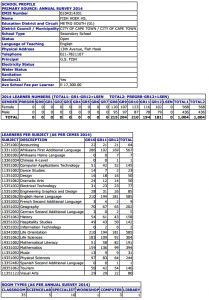Background
Fish Hoek High School is a secondary school in Fish Hoek, a suburb of Cape Town, South Africa. Statistics about the school were taken from the Western Cape Education Department website.
The school opened in 1954. In 2014 it had just over 1000 learners, with fairly consistent numbers in each of the five grades (small drops of numbers in the last two years). It appears that all, or most of, the learners have English as their home language. More learners take mathematics than mathematical literacy.
What’s happened so far…
We met Rob Douglas and Greg Hawtrey. We were taken to Rob’s classroom and were joined by Greg, who is the Head of Department.
We outlined the key points about the project, explaining in particular what the research involves, what the commitment of the teachers would mean for them and what we need to be about research ethics.
Both teachers agreed to take part and suggested that some of their colleagues might also be interested. We put forward the idea of colleagues perhaps observing Rob or Greg teaching one of the Fasmed lessons and taking part in the post-lesson discussion. This can be further discussed once Rob and Greg have some clarity about who would like to take part and in what role.
We observed both teachers teaching an ordinary lesson on 4th March. Rob’s lesson was on the topic of ‘patterns’ and involved finding the nth term in an arithmetic series. He also showed a video on the topic of patterns in nature. Greg’s lesson was also on the topic of numeric and geometric patterns and the learners completed questions from the board and from the text book. We took observation notes and produced separate reports on each lesson. The teachers were given the reports and invited to comment, but it seems they were happy with the reports.
Research lesson 1
Both teachers chose to teach the exponents lesson for the research lesson, both on 11thMarch. Greg taught it to a Grade 8 class and Rob taught it to a Grade 9 class. Rob did not finish the lesson in the period we observed, but did complete it the next day. He emailed a short report about this lesson to us.
For both lessons, we produced research reports which we have shared with the teachers.
Research lesson 2 (Rob)
Rob wanted a lesson to consolidate some of the geometry his class had been doing. We suggested one on quadrilaterals and he was enthusiastic about it. He taught it over two class periods, on 26th and 27th May. We produced a research report, as before. More about the lesson can be found here.
Research lesson 2 (Greg)
We hoped that at least one or two teachers would teach a lesson on time-distance graphs before our project meeting in Lyon (April 2015). Greg volunteered to do this with his Grade 10 class, and he taught the lesson over two class periods on 16th and 17th April. We produced a research report, as before. More about the lesson can be found here.
Research lesson 3 (Greg)
Greg said that he would like to continue working with his Grade 10 class for the research lessons. We showed him an outline of a lesson in which students match different representations of functions and non-functions and he liked it, so we developed it for him (and some others). He taught the lesson on 26th and 27th May. We produced a research report, as before. More about the lesson can be found here.
Research lesson 4 (Greg)
Greg told us that his learners had difficulty with function notation and gave us an example of the sort of question they struggled with: when is f(x) > g(x). We agreed to design a lesson to address this idea and met with him to discuss the initial design. He had some suggestions and we added these. He taught the lesson on 3rd and 4th September. We told the class it was an experimental lesson and afterwards we discussed the design with them. They had some ideas about which we took into account in the next iteration of the lesson design, which was used at Rustenburg Girls’ High School. Again, we produced a research report.
Research lesson 3 (Rob)
Rob said that he wanted to prepare his students for the forthcoming Annual National Assessments, and that he wanted to reinforce concepts about straight line graphs. We found a MAP lesson on the topic and modified it slightly, then worked through it with him. He taught the lesson on 31st August and 1st September and we produced a report on the lesson.
Wrapping up
For both classes we produced a video montage of the three lessons they had done and went into school on 6th November to show it to them. We gave each learner a small packet of Niknaks.
